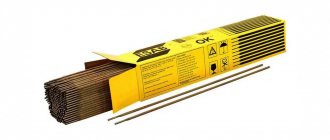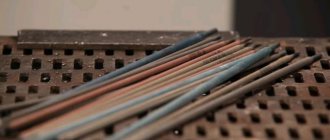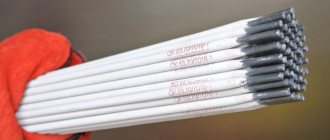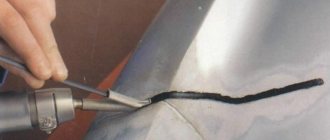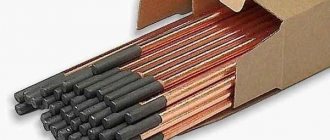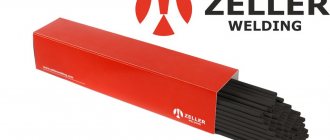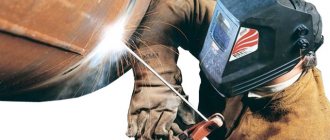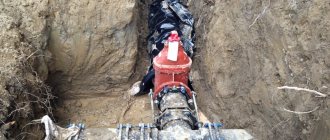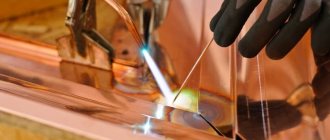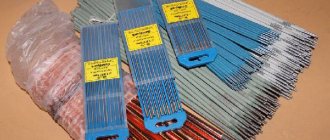An electrode for manual arc welding can be thought of as a piece of special wire coated with a special substance - coating. The rod and coating perform different jobs during welding: the wire connects the metal, and the coating improves the weld and maintains the arc. The final quality of work depends on the competent choice of both of these components. The main part of the welding electrode is its coating. In this article we will look at the types of electrode coatings for welding.
Welding wire comes in different thicknesses (from 1 to 12 mm), its diameter is considered the diameter of the electrode. Most often, rods with a thickness of 3 - 6 mm are used, as they are suitable for most typical technical tasks. But the choice of coating is not so simple: it depends both on the specifics of the work and on the qualities that the welder wants to endow with the resulting seam. That is why it is worth understanding the functions and types of coating better.
Electrode coating functions.
The electrode coating, when exposed to high temperatures, releases gas, melts and flows into the weld pool, performing several important functions at once.
Main functions of electrode coating
- Arc support and atmospheric protection. The gas resulting from heating the coating contains a large number of ions. It envelops the electric arc and supports its combustion. In addition, the gas layer helps protect the seam from oxygen, nitrogen and hydrogen contained in the atmosphere.
- Creation of a slag layer. The slag layer is formed when lighter compounds from the molten metal float to the surface. During welding, it adheres to the surface of the liquid seam, protecting it from atmospheric gases (along with a gas cloud). Slag also slows down the cooling of the metal, which improves the quality of the joint.
- Oxidation protection. Despite the fact that the gas cloud and slag shield the molten metal from atmospheric gases and water vapor, oxygen can still penetrate into the seam. If this happens, iron oxides will remain in the connection, significantly reducing the quality of the work done. The coating contains elements that capture oxygen and remove it away into the slag layer.
- Giving metal certain properties. This coating function is one of the most important. If it is necessary to ensure increased resistance of a seam to high temperatures, to increase its ductility or strength, adding impurities is necessary. Using various alloying impurities, you can give the compound the desired qualities.
The efficiency of the electrodes is largely determined by the quality of the application of the outer layer.
Pros and cons - the reason for popularity
The obvious advantages of rutile-type electrodes are the following factors:
- obtaining a seam without cracks and pores;
- high strength;
- there is no need to thoroughly clean the edges;
- the ability to use any manual arc welding equipment (transformers, generators, inverters);
- the ability to make connections in conditions of high humidity;
- easy separation of slag crust;
- the ability to connect in the desired spatial position;
- the ability to perform both tack welds and long seams.
The only disadvantages include the fact that rutile electrodes require proper storage conditions, due to the fact that the coating absorbs moisture from the air. If the conditions are violated (must be stored in a dry room), then calcination at a temperature of 160÷200 °C for an hour is required before use. The exception is the electrodes of the Swedish concern ESAB brand OK 46.00 - even when damp, they will connect the parts, and the seam will be of the required quality.
Electrode coating.
The production of electrodes and coating (coating) on them is a complex technological process that can be divided into several stages.
Video about how welding electrodes are produced. Including coating for electrodes.
- Preparation of rods. The first step is to cut the straightened welding wire into pieces of a certain length. The resulting sections are cleaned of oil, scale and oxides.
- Preparation of dry coating. First, the solid components, which in the future will be part of the coating, are dried and fired. Then they are crushed and the resulting small particles are passed through a special sieve with a fixed mesh size. Finally, the different coating components are mixed in the required proportions.
- Preparing thick coating. A solution of liquid glass is used as a basis to obtain a homogeneous mass. Ferroalloys upon contact with it enter into an undesirable active reaction, so they are additionally calcined, “passivated”. During mechanized application, the coating diluted in liquid glass is brought to the density of moist earth; with the manual method, a more liquid mass is acceptable.
- Application to the rods can be done manually or with a special automated machine. In the manual method, the wire is collected in a frame and dipped into the solution. The frame should be pulled out so that the solution is evenly distributed over the rod. In the machine method, the coating is applied under pressure, then the electrode passes through a special mouthpiece, which removes excess coating.
- Drying. After applying the solution, the electrodes are dried: first for a day in the open air at a temperature of 25 - 30 °C, and then for 1 - 2 hours in electrical cabinets, where the temperature is maintained at 150 - 300 °C.
You may find it interesting or even useful how to choose an electrode for welding. Check it out!
Types of electrode coatings for manual arc welding.
There are several main types of electrode coatings:
- sour;
- cellulose;
- rutile;
- basic.
There are also several of the most common, mixed types of electrode coating:
- acid-rutile;
- rutile-basic;
- rutile-cellulose;
- rutile with iron powder;
- others.
Let's try to understand them better.
Types of electrode coatings for RDS welding.
Sour.
It differs in that it allows you to connect parts that have a certain amount of rust or other contaminants. Welding without preliminary preparation of parts is especially effective in hard-to-reach places that are difficult to clean properly. The abundance of oxygen released from the coating also significantly speeds up the work.
Unfortunately, the strength of the connection leaves much to be desired, and after work with acid-coated electrodes, hot cracks may appear on the seam. Unpleasant facts are also strong metal spattering and toxic gases, which undermine the welder’s health. For these reasons, acidic coating is being replaced by rutile and acid-rutile.
This type got its name because of its composition, which is dominated by oxides. Thanks to them, oxygen is released during welding, which supports intense arc combustion.
Types of electrodes: E38, E42. The maximum tensile strength of the seam reaches 412 MPa.
In Russian markings this coating is known under the letter “A”, in international markings it is known as “A” (English).
Main characteristics of acid coating electrodes
Rutile coating.
Due to many positive qualities, rutile-coated electrodes have gained wide popularity. They are recommended for beginners and amateurs. Welding is simplified due to easy arc formation (including repeated arcing) and low metal spattering.
The quality of the seam is good even for novice welders. Rutile coating does not emit substances harmful to human health. The only thing you can complain about is the cost of the electrodes. Due to the higher price, professional welders often prefer acid-rutile, rutile-base or rutile-cellulose coatings.
Rutile coating is so named because of the high content of titanium dioxide, which in mineralogy is known as rutile. The composition also contains other elements: magnesium carbonate, mica, ferromanganese, granite and feldspar.
Types of electrodes: E42 - E46. Welds produced with such electrodes have a maximum strength value of 410 - 450 MPa.
Rutile coating in Russia is designated by the symbol “P”, in foreign documentation - “R”.
Characteristics of rutile coating of welding electrodes
Basic coating for the electrode.
Electrodes with a basic coating are ideal for repairing critical structures and pipelines. Due to the low release of hydrogen and oxygen, the seams retain their strength for a long time. The connections are resistant to cracks, including those caused by hydrogen sulfide mixtures (this is why it is better to weld gas pipelines using electrodes with a basic coating).
But this coating material also has unpleasant features. Before work, the electrodes must be freed from moisture, which is achieved by high-temperature calcination. The use of alternating current is unacceptable, and the connection point must be well cleaned. If these conditions are not met, the seam loses its strength.
The properties of the base coating are determined by its composition: fluorite (calcium fluoride), calcium carbonate and magnesium carbonate. Calcium fluoride, in particular, does not work well with alternating current. To prevent the formation of unwanted hydrogen, the coating must be dry. Unfortunately, it absorbs moisture well, which is why calcination is required before starting welding work.
Types of electrodes: E42A - E50A. The tensile strength of seams obtained with their help reaches 490 MPa.
In the Russian Federation, this type of coating (coating) is marked with the letter “B”, according to the international standard - with the letter “B”.
Characteristics of the main coating
Cellulose coating of electrodes.
The main distinguishing features of this type of coating are that it creates good gas protection of the seam and produces very little slag. The gas cloud prevents oxygen, nitrogen and hydrogen from the atmosphere from penetrating the metal and improves arc combustion. A minimum of slag simplifies work on vertical seams.
Although the gases produced by the combustion of the organic parts of the cellulose coating support the welding process, the presence of hydrogen among them makes the weld more brittle. Cellulose-coated electrodes cannot be used to cook hardening steel. Another unpleasant moment: the scattering of splashes during welding can reach 15%. Cellulose-coated electrodes are usually calcined, but the temperature should not exceed 120 °C.
Cellulose coating is so named because of the cellulose that predominates in the composition. This coating also contains resin and iron-containing elements. Components of organic origin are sensitive to high temperatures: when exceeding 120 degrees, they begin to decompose.
Electrode types: E42, E46 and E50. The tensile strength reaches 490 MPa.
This coating is designated in domestic documentation by the letter “C”, according to the ISO standard - “C”.
Characteristics of cellulose coating
A must read for everyone! Safety precautions when carrying out welding work. Don't joke with your health and the health of others!
Compound
Rutile electrodes are made from various types of welding wire and coated with a titanium oxide flux of the composition TiO2.
A distinctive feature of the flux is the presence of an organic gas-protective component in its composition. In this regard, the rods must be dried before use.
The presence of moisture in the coating will lead to hydrogenation of the compound.
It is quite simple to distinguish this type of electrode from others by markings. The brands have the letter “P” in their designation, indicating the type of flux. So these welding electrodes can be easily distinguished from others and not be mistaken.
What does the electrode coating consist of?
To create an electrode coating with specified properties, various ingredients and their combinations are used. All of them can be divided into categories according to the role they perform in welding.
The main component of the electrode coating
- Gas-forming. When welding, they create a gas cloud around the arc. This gas prevents oxygen, hydrogen and nitrogen from the atmosphere from penetrating the metal. This category includes: cellulose, food flour, wood flour, dextrin, starch and carbonates.
- Slag-forming. A slag layer is formed, which protects the metal from the atmosphere and slows down its cooling. These include: dolomite, marble, kaolin, manganese ore, quartz sand, chalk, feldspar, titanium concentrate and other substances that can be converted into slag.
- Alloying. These additives give the weld metal special properties: strength, ductility, resistance to oxidation, high and low temperatures. Among these substances: tungsten, molybdenum, titanium, manganese, nickel, vanadium and chromium.
- Deoxidizing. Oxygen in welded joints increases the brittleness of the metal. You can remove it by adding aluminum, silicon, titanium or manganese to the molten metal.
- Stabilizing. They could also be classified as gas-forming, since they also emit gas. But this gas is not intended to protect the weld pool, but to maintain the arc. This includes chromate, saltpeter, potash and other potassium compounds.
- Binders. The purpose of these coating components is to connect the coating elements to each other and to the welding wire. Liquid glass is most widely used as a binding component.
- Shaping. They improve the plastic properties of the coating, which is important when applying the coating by machine. These substances include kaolin, bentonite and others.
To increase the efficiency of the welding process, iron powder can be added to the electrode coating.
Some ingredients can perform more than one function: for example, create a protective gas cloud that supports the arc, and then turn into slag that protects the weld metal.
What affects the quality of welding with an inverter
We have already told you which electrodes are best for welding with an inverter and are ready to move on to the factors that influence the quality of the weld.
- Welder skills and experience. This is the determining factor. An experienced and competent welder can always perform high-quality welding in compliance with all technologies. Please note that we wrote “skills and experience”, since there are types of industries in which welders perform monotonous work. For example, a welder who performs only horizontal welds in production will most likely not be able to perform high-quality vertical welds from top to bottom. In no case do we want to offend welders, but such cases have occurred in practice. It’s not for nothing that there is a special certification of welders at NAKS, the passage of which gives access to certain types of work.
- Quality of materials. This is the second determining factor. Electrodes for welding with an inverter must be of high quality. They must also be stored correctly and calcined before use according to the recommendations indicated on the packaging.
- Equipment quality. The inverter must be of high quality, capable of providing stable operation. A common problem with low-quality equipment is voltage surges, the inability to stabilize the arc, and sticking of the electrode.
We have listed three main factors that affect the quality of a welded joint. This also includes the correct selection of the diameter of the product, its brand, setting the current strength, the conditions under which the work is carried out, and much more.
